|
A
few days ago, on Sol 33, the Martian Rover
"Opportunity" was commanded to roll
forward to begin intensive investigation of a
small section of the rocky outcrop, rimming this
small crater that it's been exploring in a region
of Mars, called "Meridiani Planum,"
since shortly after it landed there, January 25 th
. The overall, few inches high outcrop, which
spans approximately 180 degrees of the crater's
interior, has been dubbed by the JPL Rover Team
"Opportunity Ledge." The specific
section that Opportunity was ordered to
investigate last week is about in the middle of
this outcrop (below), is approximately ten inches
high, and was named by the Team "El
Capitan."
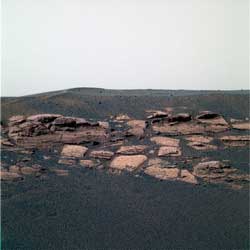
Preparatory
to actually drilling into El Capitan and making
detailed composition measurements with the array
of sophisticated instruments on the Rover's
"arm," Opportunity was commanded to take
a series of close-up Microscopic Images of the
untouched surface of the rock with the B&W CCD
camera attached to the arm. One of those images
revealed an amazing sight (below):
A potential Martian
fossil?!
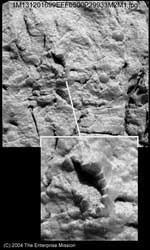
A close-up
enlargement of this fascinating object (above
bottom), reveals an apparently "snapped
off" body geometry, at least five visible
cylindrical "segments," and a hint of
other fossil-like features buried in the
surrounding rock itself all classic hallmarks
of a former living organism!
So, what did the
JPL Rover science Team do with this potentially
explosive scientific find
?
They promptly
ground it into powder
right before our eyes (PanCAm
color image, below)!
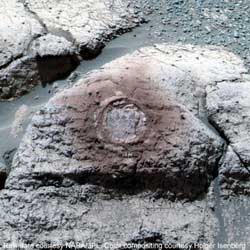
As the second
Microscopic Image, taken immediately after this
grinding operation clearly shows (below), rather
than move the grinder (technically called the
"Rock Abrasion Tool" RAT) a couple
of inches to the left or right, the grinding of
the rock took place directly over this
astonishing fossil-looking object
.
Totally obliterating it.
The raw
"before" and "after" images of
this wanton and inexplicable destruction can still
be seen at the JPL Mars Exploration Rover Mission
homepage.
After we discovered and posted
an initial version of this remarkable series of
events on "Enterprise" March 2, as might
be expected (for a website which received almost
40 million hits in January alone) we began
receiving e-mails from around the world -- from
amateur and professionals alike -- all pointing
out an almost unbelievable resemblance between
"our" Martian fossil
and a
well-known terrestrial counterpart.
Quoting from one correspondent,
James Calhoun:
I have been a
collector of marine fossils for 34 years, an
amateur to be sure, but with years of field
experience. When I saw the "Fossil"
pic [on "Enterprise"], it was clear to
me that it met a number of the basic criteria of
fossilization. RCH was correct in that
"scale does not matter," as the
physical characteristics of the item are
immediately apparent, and it is sad that the MER
team did not present a professional
paleontologist to comment. In that light, I have
heard a varied number of explanations as to what
type of fossil this could be, everything from a
segmented worm (annelid) to a shrimp
(crustacean). I would like you guys to consider
that based on the symmetry of the object, that
it could be in fact an early Crinoid, a filter
feeding marine plant-like animal, a type with a
calcium carbonate exoskeleton (this is
Earth-based of course, the Martian exoskeleton
[could] have been of a differing mineral
composition). I have included a couple of
pictures for symmetry and scale reference.
Notice the triangular symmetry in the
"branch areas," not to mention the
segments, and also that the scale is inline with
the "size of the blueberries." Your
opinion would be most appreciated. Thanks for
your time and I appreciate the work the team
does."
Mr. James C.
Calhoun (Jim)
Lancaster, NY
The images Jim
included with his e-mail "knocked our socks
off," as the saying goes.
Chosen from " A
Beginners Guide To Identifying Cincinnatian
Crinoids, "by Jack Kallmeyer, they
clearly showed that the fossilized Martian
"creature" we'd discovered on this
series of Opportunity's Microscopic Images for
Sol 33, shared an amazing number of specific characteristics
with one "Ordovician Crinoid Retercrinus
Alvealatus" (below).
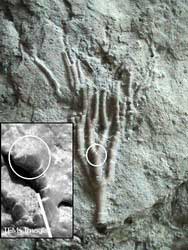
Other mages Mr.
Calhoun sent revealed even further similarities
(below).
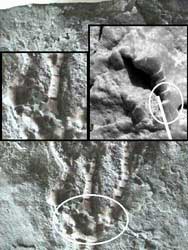
Among the many
responses to our posting of this extraordinary
terrestrial fossil analog, was one from our
long-time friend and colleague, Ron Nicks. Ron, as
you may remember, is one of our Enterprise
consulting geologists, who's written a number of
thoughtful analyses on prior NASA missions and
results.
For several days
prior to this, Ron and I had been arguing back an
forth via e-mail about the "Martian
blueberries" that Jim Calhoun alluded to
those curiously spherical, highly uniform "somethings"
that litter the Opportunity crater
literally,
in the millions .
As seen in this
PanCam color image (below), not only are these
mysterious objects amazingly abundant and
apparently contained within the rocks
(until released through slow erosion), in properly
calibrated images they are actually blue (contrary
to the Rover Science Team Principal Investigator
Stephen Squyres' increasingly curious denials at
NASA press conferences, "They're NOT blue
" -- after it was he who originally termed
them "blueberries"
)
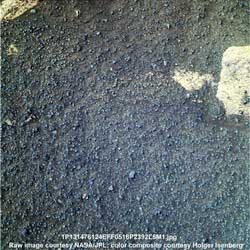
In fact, other than
noting their great profusion and color, the major
mystery of "what are they, really?"
the most obvious "anomalous features" of
this entire Martian landscape -- had not been
publicly addressed directly by the Rover Science
Team
even after a full month at Meridiani
Planum.
Ron had been
arguing that the "berries" were also
some kind of preserved life form, specifically
representative of a separate Class of marine
invertebrate animals (now extinct on Earth) called
"blastoids." Fossilized blastoids
(commonly called "fossil Rose Buds" or
"Hickory Nuts" in the southeastern
United States where a lot of their fossils
have been found) at first glance resemble a hard
fruit common to many current trees. In fact, they
are the partially petrified remains of a marine
organism which (like the Crinoids see below)
stood above the sea floor on a long, segmented
"stem" and gathered food from the
surrounding currents with a waving set of
tentacles (rarely preserved) called "pinnules"
(below).
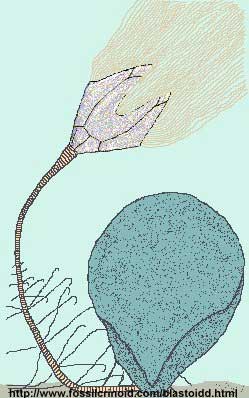
One common blastoid
form, because of its striking five-sided symmetry
(below), is called "Pentremites."
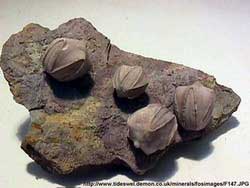
When Opportunity
rolled up and took its first close in PanCam color
images of a feature of "Opportunity
Ledge" called "Stone Mountain"
(below), the spacecraft was also commanded to
acquire Microscopic Images at the same time
(inset).
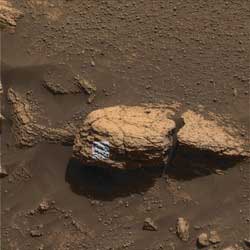
Notice on the MI
image (below), the series of extremely thin,
parallel, sedimentary layers in this rocky outcrop
(1M129516156EFF0312P2933M2M1.jpg), which also
includes a couple of dangling "Martian
blueberries," partially exposed.
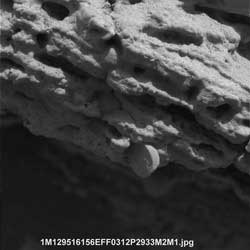
Ron, in examining
the "blueberries" on several of these
and other close-ups, believed he'd spotted the
tell tale, five-sided signature of Pentremites!
In a carefully
composited color version of this same image,
created by another Enterprise associate, Jill
England, the details of some "berries"
become clear. As you enlarge the
"berries," distinct hints of five-sided,
geometric surface features eerily similar to
fossilized terrestrial blastoids finally do
appear (below).
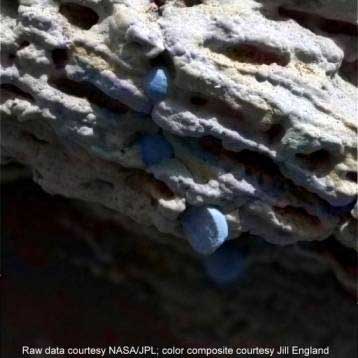
Though eroded by
unknown length of exposure to the Martian winds
and sands which over time have almost removed
all surface markings and relief -- enough remains
to make some interesting comparisons
.
Based on his
paleontological experience, Ron had been arguing
for days that these tantalizing clues pointed to a
fossil explanation for the mysterious
"blueberries" as opposed to the
strictly geological explanations being officially
advanced by the Rover Science Team.
While intrigued, I was not
convinced ...
Then
I found the fossil
on the Sol 33 Rover MI image, and posted it on Enterprise.
James Calhoun's highly provocative confirmatory
e-mail and images arrived. And, Ron wrote
again:
Richard,
Remember my
[earlier] e-mail regarding crinoid stems? That
is exactly what you are looking at in the
"segments" that you describe [on
"Coast to Coast AM," and in the latest
"Enterprise" posting]. A crinoid stem
has the appearance of a stack of lifesavers. In
the same image, you can see what appears to be
the blastoids
or cystoids that top the stems. This deposit
looks exactly like much limestone in the
Cincinatti, Ohio area.
Ron
What are the odds
of two independent experts who have never met,
let alone talked to one another on this subject!
separately identifying this specific crinoid's
fossil on a random Martian image ... and then, the
precise region on Earth where it's counterpart is
found?!
OK, what's a "Crinoid?"
A crinoid
[sometimes called a "sea lily," because
of its superficial appearance to a spreading
flower (below)] is, as James Calhoun described,
"a filter feeding, marine, plant-like animal
." Crinoids first appeared in Earth's
primeval seas over 500 million years ago, in the
so-called "Cambrian Era," climbing to
dominance over the next 150 million years, before
receding once again in the terrestrial fossil
record.
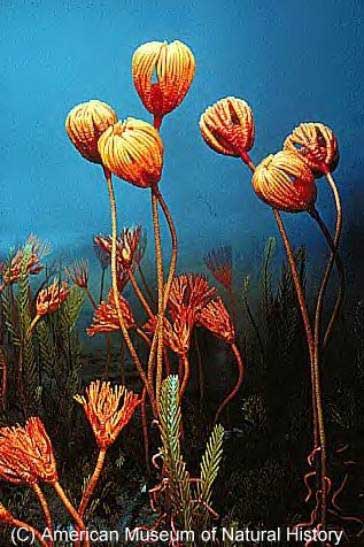
UCLA's "astrobiology"
website features several Crinoid
reconstructions through geological time, some
(below) carefully detailing their various
components.
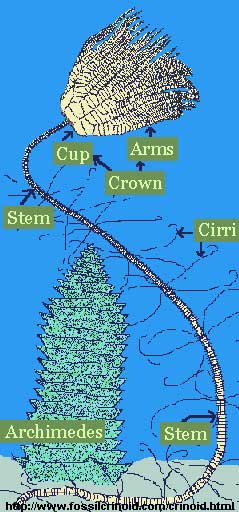
The section of our
fossilized Martian equivalent -- apparently
captured in the Opportunity Microscopic Image from
Sol 33 -- was the base of the "cup" and
a small portion of one segmented "arm"
(compare above and below). The other arms, which
were used to gather food from the underwater ocean
currents when the organism was alive, apparently
had eroded away (or been blasted away by the
creation of this Martian crater)
long before
NASA's Opportunity Rover landed in the crater and
took the specific image
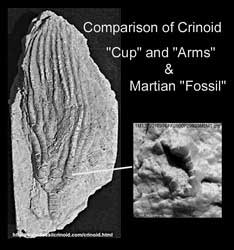
The mysteries
presented by this astonishing discovery are far
too complex to even begin to explore in any depth
here. But a few questions seem in order
.
Given that this is
real, that all of us now who have independently
looked at this, and come to the same
conclusion -- that this could in fact be a
genuine Martian fossil at Maridiani Planum -- are not
delusional
what could it mean?
A few days after
the acquisition of this remarkable image, NASA
held a sudden "water
press conference" in Washington DC. There
they announced, with much fanfare, that
Opportunity had discovered via its analytical
equipment, measuring the chemistry of the outcrop
-- that the site it was exploring once " was
soaking wet in the past." While refraining
from also claiming that "Opportunity
Ledge's" layers of sediments had been laid
down in actual liquid water, they came very close
and hinted that this confirmation could come
"as early as a few days."
So, what do we have here?
Crinoids lived in
ocean water ranging from a few feet deep to
several miles anchoring their stems on the
ocean floor and feeding on whatever nutrients
drifted by. If you look at a combined map of where
JPL landed its two Rovers, and the Odyssey GRS
orbital determination of water abundance in the
upper one meter of Martian soil, a glance will
suffice to show the Rovers are indeed exploring
none other than the shallows of our two proposed
equatorial Martian tidal oceans (below)! Almost as
if that had been planned
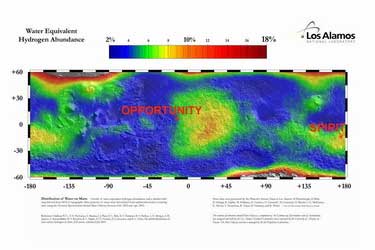
It takes almost no
imagination (so, even the current Rover Team might
handle it
) to picture this site several
million years ago (below) -- a quiet tidal pool,
filled with gently waving creatures of the sea
until one day, something extraordinary happened
and this pool and all of Mars forever changed.
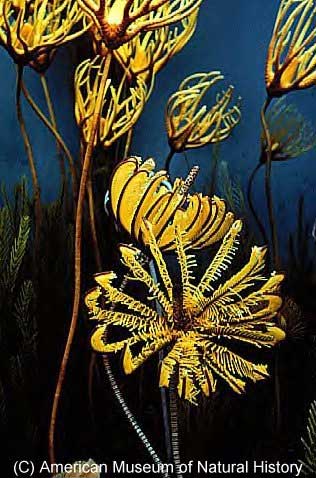
The fact that our
small Martian creature seems identical to
the Crinoids which once dominated Earth's
terrestrial oceans is astounding. That fact alone
if it is a fact means that something is
radically wrong with our current view of
biological, if not planetary, evolution. Verifying
that simple fact would seem now to be the highest
priority for a space program about to undertake
significant new challenges
including multi-generational
planning for human flights to Mars.
It is so easy to
invoke the idea of "parallel evolution"
to explain this astonishing development. But is
such a concept especially on two totally
different planets, with totally differing
environments and histories -- even plausible
science fiction
let alone scientific fact?
Could not one just as easily invoke the
intervention of an "outside agency"
including a Creator -- to explain the appearance,
on these two separate worlds, of a species
essentially identical in function and in
form
?
And, if that can be
done here, where does invocation of such an
"outside intervention" end? With the
appearance of the Face on Mars itself
?
The idea of landing
a robot (essentially at random) on an alien planet
only to discover an ancient form of terrestrial
life (maybe two if the
"blueberries" turn out to be Ron's
blastoids!), so immediately recognizable that
literally dozens of observers on this planet
amateurs and experts alike have now
independently identified it, raises profound
philosophical and scientific questions
to
which we now desperately need real scientific
answers.
Unfortunately, if
we expect our own Space Agency to publicly address
let alone answer any of them
based on NASA's current actions vis a vis this fossil
we may be waiting a very long, long time
.
* * *
One final mystery:
In 2000, Geoffrey
Landis a NASA scientist attached to the
NASA-Glenn Research Center, in Ohio wrote his
first Mars science fiction novel, " Mars
Crossing ."
In 1997, Landis had
been a Principal Investigator for one experiment
on the highly successful first unmanned Mars
Pathfinder Sojourner rover mission to the outflow
of an ancient water channel, Ares Vallis. As a
result, his "Mars" in the new novel was
highly praised, by both veteran science fiction
writers and planetary scientists alike, as
"totally authentic." One wrote:
"High-quality
hard SF written with the authenticity of a NASA
insider
Landis has given us a legend of our
own near future
."
Geoffrey Landis is
also now a member of the current JPL Rover Science
Team, a member of the "atmospheric
group." Which makes what he did in his novel
four ago, very interesting ... to say the
least.
Three quarters
through his novel, Landis has one of his
characters, Brandon Weber, get lost in the arid
Martian desolation of endless dunes and dust.
Tired and scared, the astronaut finally climbs a
small butte to get his bearings
and makes a
startling, serendipitous discovery
.
There was a
fracture line running down the middle of the
butte; one half of it was two feet higher than
the other. It made a natural seat. Without any
sense of wonder, without even a sense of
irony, he reached out and touched it. Embedded
in the layered sandstone exposed by the crack,
it held a perfectly preserved fossil. It
looked like a cluster of shiny black hoses,
clumped together at the bottom, branching out
into a dozen tentacles at the top. In the
same section of rock, he could see others, of
every size from tiny ones to one three feet
long. There were other fossils too, smaller
ones in different shapes, a bewildering
variety.
"I name
you Mars Life Brandonii," he said.
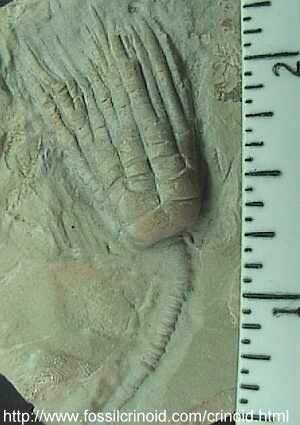
How did Landis -- a
Pathfinder and MER Rover Mission NASA scientist --
somehow know ... four years ago?!
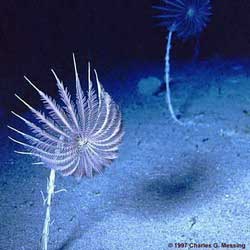
|